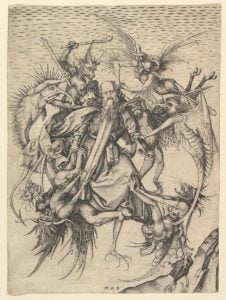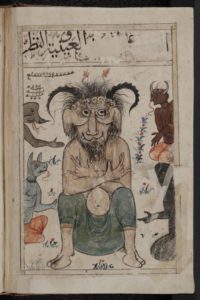Christianity
Christian Bible
Old Testament

Demons in the Old Testament of the Christian Bible are of two classes: the “satyrs” or “shaggy goats” (from Hebr. se’irim “hairy beings” and Greek Old Testament σάτυρος satyros, “satyr”; Isaiah 13:21, 34:14) and the “demons” (from Hebr. shedim, and Koine Greek δαιμόνιον daimonion; 106:35–39, 32:17).
New Testament
The term “demon” (from the Greek New Testament δαιμόνιον daimonion) appears 63 times in the New Testament of the Christian Bible.
Pseudepigrapha and Deuterocanonical books
Demons are sometimes included into biblical interpretation. In the story of Passover, the Bible tells the story as “the Lord struck down all the firstborn in Egypt” (Exodus 12:21–29). In the Book of Jubilees, which is considered canonical only by the Ethiopian Orthodox Church, this same event is told slightly differently: “All the powers of [the demon] Mastema had been let loose to slay all the first-born in the land of Egypt…And the powers of the Lord did everything according as the Lord commanded them” (Jubilees 49:2–4).
In the Genesis flood narrative the author explains how God was noticing “how corrupt the earth had become, for all the people on earth had corrupted their ways” (Genesis 6:12). In Jubilees the sins of man are attributed to “the unclean demons [who] began to lead astray the children of the sons of Noah, and to make to err and destroy them” (Jubilees 10:1). In Jubilees Mastema questions the loyalty of Abraham and tells God to “bid him offer him as a burnt offering on the altar, and Thou wilt see if he will do this command” (Jubilees 17:16). The discrepancy between the story in Jubilees and the story in Genesis 22 exists with the presence of Mastema. In Genesis, God tests the will of Abraham merely to determine whether he is a true follower, however; in Jubilees Mastema has an agenda behind promoting the sacrifice of Abraham’s son, “an even more demonic act than that of the Satan in Job.” In Jubilees, where Mastema, an angel tasked with the tempting of mortals into sin and iniquity, requests that God give him a tenth of the spirits of the children of the watchers, demons, in order to aid the process. These demons are passed into Mastema’s authority, where once again, an angel is in charge of demonic spirits.
The sources of demonic influence were thought to originate from the Watchers or Nephilim, who are first mentioned in Genesis 6 and are the focus of 1 Enoch Chapters 1–16, and also in Jubilees 10. The Nephilim were seen as the source of the sin and evil on earth because they are referenced in Genesis 6:4 before the story of the Flood. In Genesis 6:5, God sees evil in the hearts of men. The passage states, “the wickedness of humankind on earth was great”, and that “Every inclination of the thoughts of their hearts was only continually evil” (Genesis 5). The mention of the Nephilim in the preceding sentence connects the spread of evil to the Nephilim. Enoch is a very similar story to Genesis 6:4–5, and provides further description of the story connecting the Nephilim to the corruption of humans. In Enoch, sin originates when angels descend from heaven and fornicate with women, birthing giants as tall as 300 cubits. The giants and the angels’ departure of Heaven and mating with human women are also seen as the source of sorrow and sadness on Earth. The book of Enoch shows that these fallen angels can lead humans to sin through direct interaction or through providing forbidden knowledge. In Enoch, Semyaz leads the angels to mate with women. Angels mating with humans is against God’s commands and is a cursed action, resulting in the wrath of God coming upon Earth. Azazel indirectly influences humans to sin by teaching them divine knowledge not meant for humans. Asael brings down the “stolen mysteries” (Enoch 16:3). Asael gives the humans weapons, which they use to kill each other. Humans are also taught other sinful actions such as beautification techniques, alchemy, astrology and how to make medicine (considered forbidden knowledge at the time). Demons originate from the evil spirits of the giants that are cursed by God to wander the earth. These spirits are stated in Enoch to “corrupt, fall, be excited, and fall upon the earth, and cause sorrow” (Enoch 15:11).
The Book of Jubilees conveys that sin occurs when Cainan accidentally transcribes astrological knowledge used by the Watchers (Jubilees 8). This differs from Enoch in that it does not place blame on the Angels. However, in Jubilees 10:4 the evil spirits of the Watchers are discussed as evil and still remain on earth to corrupt the humans. God binds only 90 percent of the Watchers and destroys them, leaving 10 percent to be ruled by Mastema. Because the evil in humans is great, only 10 percent would be needed to corrupt and lead humans astray. These spirits of the giants also referred to as “the bastards” in the Apotropaic prayer Songs of the Sage, which lists the names of demons the narrator hopes to expel.
Christian demonology
In Christianity, demons are corrupted spirits carrying the execution of Satan’s desires. They are generally regarded as three different types of spirits:
Souls of the wicked deceased, which roam the earth to torment the living.
Nephilim, who came into being by union between angels and human, but their bodily part were wiped out during the Great flood. Their spiritual part now desires reembodiment.
Fallen angels, who sided with Lucifer and were cast out of heaven by Michael after battle.
Often deities of other religions are interpreted or identified as such “demons” (from the Greek Old Testament δαιμόνιον daimonion). The evolution of the Christian Devil and pentagram are examples of early rituals and images that showcase evil qualities, as seen by the Christian churches.
Since Early Christianity, demonology has developed from a simple acceptance of demons to a complex study that has grown from the original ideas taken from Jewish demonology and Christian scriptures. Christian demonology is studied in depth within the Roman Catholic Church, although many other Christian churches affirm and discuss the existence of demons.
Building upon the few references to daemons in the New Testament, especially the poetry of the Book of Revelation, Christian writers of apocrypha from the 2nd century onwards created a more complicated tapestry of beliefs about “demons” that was largely independent of Christian scripture.
The contemporary Roman Catholic Church unequivocally teaches that angels and demons are real beings rather than just symbolic devices. The Catholic Church has a cadre of officially sanctioned exorcists which perform many exorcisms each year. The exorcists of the Catholic Church teach that demons attack humans continually but that afflicted persons can be effectively healed and protected either by the formal rite of exorcism, authorized to be performed only by bishops and those they designate, or by prayers of deliverance, which any Christian can offer for themselves or others.
At various times in Christian history, attempts have been made to classify demons according to various proposed demonic hierarchies.
In the Gospels, particularly the Gospel of Mark, Jesus cast out many demons from those afflicted with various ailments. He also lent this power to some of his disciples (Luke 10:17).
Apuleius, by Augustine of Hippo, is ambiguous as to whether daemons had become “demonized” by the early 5th century:
He [Apulieus] also states that the blessed are called in Greek eudaimones, because they are good souls, that is to say, good demons, confirming his opinion that the souls of men are demons.
Islam

Islam and Islam-related beliefs acknowledges the concept of evil spirits known as malevolent Jinn, Afarit and Shayatin. Unlike the belief in angels, belief in demons is not obligated by the six articles of Islamic faith. However, the existence of several demonic spirits is generally assumed by Islamic theology and further elaborated beliefs persist in Islamic folklore. Furthermore the Quran mentions the Zabaniyya, who torture the damned in hell, who may originated from a class of Arabian demons. However, their execution of punishment is in accordance with Gods order, therefore they are not equalized with Shayatin, who in turn are rebellious against the divine will.
Jinn and Shayatin
Rather than demonic, Jinn are depicted as close to humans regarded as living in societies, in need of dwelling places, eating and drinking, and although their lifespan exceeds those of humans over centuries, they die and also need to procreate, but because they are created from smokeless fire in contrast to humans made from solid earth, the latter can not see them. As for humans, Jinn are also subject to temptations of the Shayatin and Satan therefore may either be good or evil. Evil Jinn are comparable to demons, scaring or possessing humans. In folklore some Jinn may also lurk on lonely travelers to dissuade them from their paths and eat their corpses. Although not evil, a Jinni may haunt a person, because it feels offended by him. Islam has no binding origin story of Jinn, but Islamic beliefs commonly assume that the Jinn were created on a Thursday thousands of years before mankind. Therefore Islamic medieval narratives often called them Pre-Adamites.
Otherwise the Shayatin are the Islamic equivalent of “demons” in western usage. Islam differs in regard of the origin of demons. They may either be a class of heavenly creatures cast out of heaven or the descendants of Iblis. Unlike Jinn and humans, Shayatin are immortal and will just die, then the world perishes, however prayers could dissolve or banish them. However unlike Jinn and human, Shayatin can not attain salvation. Further they are thought to attempt to reach to heaven, but are chased away from the Angels or shooting stars. The Shayatin do not possess people, but “whisper” to their minds and seduce them into falsehood and sin. These are called waswās and may enter the hearts of humans to support negative feelings, especially in states of strong emotion like depression or anger.
Ifrit
Another demonic spirit is called Ifrit and although there are no descriptions regarding an Iftrits behavior found in Islamic canonical texts, Folk Islam often depicts them with traits of malevolent ghost, returning after death or a subcategory of Shayatin drawn the life-force of those who were murdered. However, they are not exactly Shayatin since they differ in their origin.
